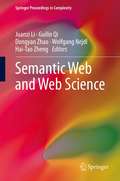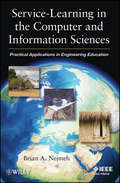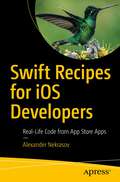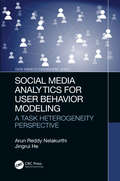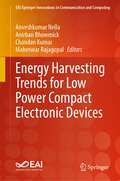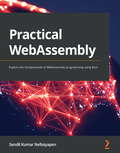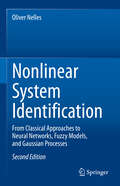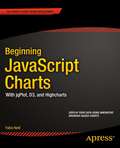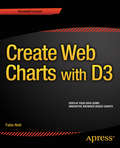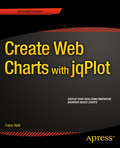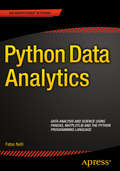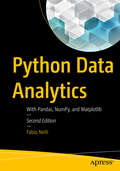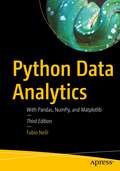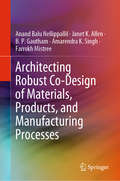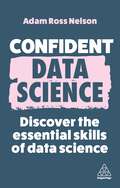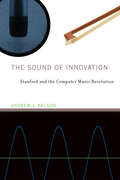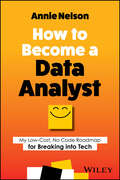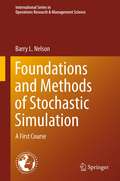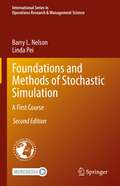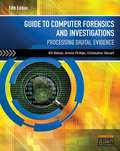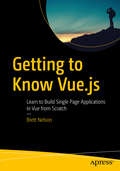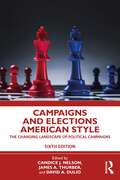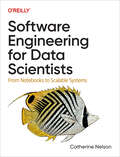- Table View
- List View
Semantic Web and Web Science
by Wolfgang Nejdl Dongyan Zhao Guilin Qi Hai-Tao Zheng Juanzi LiThe book will focus on exploiting state of the art research in semantic web and web science. The rapidly evolving world-wide-web has led to revolutionary changes in the whole of society. The research and development of the semantic web covers a number of global standards of the web and cutting edge technologies, such as: linked data, social semantic web, semantic web search, smart data integration, semantic web mining and web scale computing. These proceedings are from the 6th Chinese Semantics Web Symposium.
Service-Learning in Computer and Information Sciences
by Brian A. NejmehA road map for service-learning partnerships between information science and nonprofit organizations While service-learning is a well-known educational method for integrating learning experiences with community service, it is only now beginning to emerge in computer and information sciences (CIS). Offering a truly global perspective, this book introduces for the first time an essential framework for service learning in CIS, addressing both the challenges and opportunities of this approach for all stakeholders involved--faculty, students, and community nonprofit organizations (NPOs), both domestic and abroad. Service-Learning in the Computer and Information Sciences outlines numerous examples of successful programs from around the world, presenting practical working models for implementing joint projects between NPOs and academia. It provides faculty members with vital insight into how to coordinate projects with a community partner, arms students with real-world problem-solving skills specific to issues faced by NPOs, and gives NPOs the expertise to leverage information technology to improve the overall value of their services. This book: Shows academics how to interact with local and global NPOs for mutually beneficial project partnerships Helps IS students enhance their classroom experience through community service, preparing them for the workforce Examines the range of available options for service learning in CIS, especially project-based or capstone courses Includes case studies from technologically challenged regions Helps NPOs become better users of technology in such areas as marketing, fundraising, and communications
Swift Recipes for iOS Developers: Real-Life Code from App Store Apps
by Alexander NekrasovBoost your iOS developer career by learning from real-life examples and start writing code for one of the most successful platforms ever. No matter if you’re an experienced developer or just a beginner, you’ll find something new and something useful for your future projects here. All of the recipes in this book are taken from real-life commercial projects that have been approved by Apple and published on the App Store. You won’t write “Hello, world!” and similar programs. Instead you'll see how to parse different data formats; run JavaScript code right inside your iOS app; and enhance storyboard editor with several simple extensions. You’ll make beautiful modern-looking dialogs with blurs, shadows and rounded corners using only a few lines of code, and safely convert data after analyzing text strings. Go on to animate your layout and get your app shored up to crash as little as possible Each recipe offers a code snippet to copy and paste to your project as a tool to boost your knowledge, as well as, create plug-and-play features. Each of recipe shows the description for each line of code while explaining the logic of it, contains references to documentation, and gives you an opportunity to modify or write something similar that fits your project better. A good piece of code should not work but also be short, clear, and stable. And that combo will be our priority in these code recipes. Well-written code snippets must run in any environment and be easily transferrable from one project to another. Most of the provided recipes will migrate from one project to another with little to no changes at all, and with years of real-world application have proven themselves to be useful and stable. Dive into the world of iOS development and write clear, functioning, and safe Swift code! What You'll LearnParse, convert, and print Swift data Develop stunning UIs quickly Write effective and portable Swift extensions Make your code cleaner and safer Who This Book Is ForBeginners in iOS development who want to improve their skills with real-life examples. Developers switching to mobile development from other areas. All iOS developers looking for code recipes.
Social Media Analytics for User Behavior Modeling: A Task Heterogeneity Perspective (Data-Enabled Engineering)
by Arun Reddy Nelakurthi Jingrui HeWinner of the "Outstanding Academic Title" recognition by Choice for the 2020 OAT Awards. The Choice OAT Award represents the highest caliber of scholarly titles that have been reviewed by Choice and conveys the extraordinary recognition of the academic community. In recent years social media has gained significant popularity and has become an essential medium of communication. Such user-generated content provides an excellent scenario for applying the metaphor of mining any information. Transfer learning is a research problem in machine learning that focuses on leveraging the knowledge gained while solving one problem and applying it to a different, but related problem. Features: Offers novel frameworks to study user behavior and for addressing and explaining task heterogeneity Presents a detailed study of existing research Provides convergence and complexity analysis of the frameworks Includes algorithms to implement the proposed research work Covers extensive empirical analysis Social Media Analytics for User Behavior Modeling: A Task Heterogeneity Perspective is a guide to user behavior modeling in heterogeneous settings and is of great use to the machine learning community.
Energy Harvesting Trends for Low Power Compact Electronic Devices (EAI/Springer Innovations in Communication and Computing)
by Anveshkumar Nella Anirban Bhowmick Chandan Kumar Maheswar RajagopalThis book focuses on the numerous energy harvesting techniques and their system implementation towards the fulfilment of energy requirements in compact electronic devices. These cover a wide range of applications in portable devices, bio-medical services, agriculture needs, mechanical systems, sensor networks, automobiles, food sector, home appliances, industry needs, etc. The authors detail energy harvesting methods using the latest technologies in acoustics, bio-chemical, thermal, artificial light, fluid flow, vibrations, EM energy, RF energy, piezoelectric, electrostatic, photovoltaic, thermoelectric, hybrid harvesting, ultrasonic, infrared, light, wind, and solar. The book is intended for researchers, academics, professionals, and students in energy harvesting.
Practical WebAssembly: Explore the fundamentals of WebAssembly programming using Rust
by Sendil Kumar NellaiyapenUnderstand the basic building blocks of WebAssembly and learn, install, and use various tools from the Rust and WebAssembly ecosystemKey FeaturesUnderstand the Rust programming language and WebAssembly concepts for web developmentBuild web, mobile, and embedded apps using WebAssemblyEnhance the scalability and resilience of your web appsBook DescriptionRust is an open source language tuned toward safety, concurrency, and performance. WebAssembly brings all the capabilities of the native world into the JavaScript world. Together, Rust and WebAssembly provide a way to create robust and performant web applications. They help make your web applications blazingly fast and have small binaries. Developers working with JavaScript will be able to put their knowledge to work with this practical guide to developing faster and maintainable code. Complete with step-by-step explanations of essential concepts, examples, and self-assessment questions, you'll begin by exploring WebAssembly, using the various tools provided by the ecosystem, and understanding how to use WebAssembly and JavaScript together to build a high-performing application. You'll then learn binary code to work with a variety of tools that help you to convert native code into WebAssembly. The book will introduce you to the world of Rust and the ecosystem that makes it easy to build/ship WebAssembly-based applications. By the end of this WebAssembly Rust book, you'll be able to create and ship your own WebAssembly applications using Rust and JavaScript, understand how to debug, and use the right tools to optimize and deliver high-performing applications.What you will learnExplore WebAssembly and the different tools available in the WebAssembly ecosystemUnderstand the raw WebAssembly binary and the WebAssembly text formatUse the Web and JavaScript API with wasm-bindgenOptimize Rust and WebAssembly for high performanceRun and debug WebAssembly and Rust codeExplore various tools available in the RustWASM ecosystemWho this book is forThis book is for JavaScript developers who want to deliver better performance and ship type-safe code. Rust developers or backend engineers looking to build full-stack applications without worrying too much about JavaScript programming will also find the book useful.
Nonlinear System Identification: From Classical Approaches to Neural Networks, Fuzzy Models, and Gaussian Processes
by Oliver NellesThis book provides engineers and scientists in academia and industry with a thorough understanding of the underlying principles of nonlinear system identification. It equips them to apply the models and methods discussed to real problems with confidence, while also making them aware of potential difficulties that may arise in practice. Moreover, the book is self-contained, requiring only a basic grasp of matrix algebra, signals and systems, and statistics. Accordingly, it can also serve as an introduction to linear system identification, and provides a practical overview of the major optimization methods used in engineering. The focus is on gaining an intuitive understanding of the subject and the practical application of the techniques discussed. The book is not written in a theorem/proof style; instead, the mathematics is kept to a minimum, and the ideas covered are illustrated with numerous figures, examples, and real-world applications. In the past, nonlinear system identification was a field characterized by a variety of ad-hoc approaches, each applicable only to a very limited class of systems. With the advent of neural networks, fuzzy models, Gaussian process models, and modern structure optimization techniques, a much broader class of systems can now be handled. Although one major aspect of nonlinear systems is that virtually every one is unique, tools have since been developed that allow each approach to be applied to a wide variety of systems.
Beginning JavaScript Charts: With jqPlot, d3, and Highcharts
by Fabio NelliBeginning JavaScript Charts shows how to convert your data into eye-catching, innovative, animated, and highly interactive browser-based charts. This book is suitable for developers of all experience levels and needs: for those who love fast and effective solutions, you can use the jqPlot library to generate charts with amazing effects and animations using only a few lines of code; if you want more power and need to create data visualization beyond traditional charts, then D3 is the JavaScript library for you; finally, if you need a high-performance, professional solution for interactive charts, then the Highcharts library is also covered. If you are an experienced developer and want to take things further, then Beginning JavaScript Charts also shows you how to develop your own graphics library starting from scratch using jQuery. At the end of the book, you will have a good knowledge of all the elements needed to manage data from every possible source, from high-end scientific instruments to Arduino boards, from PHP SQL databases queries to simple HTML tables, and from Matlab calculations to reports in Excel. You will be able to provide cutting-edge charts exploiting the growing power of modern browsers. Create all kinds of charts using the latest technologies available on browsers (HTML5, CSS3, jQuery, jqPlot, D3, Highcharts, and SVG) Full of step-by-step examples, Beginning JavaScript Charts introduces you gradually to all aspects of chart development, from the data source to the choice of which solution to apply. This book provides a number of tools that can be the starting point for any project requiring graphical representations of data, whether using commercial libraries or your own What you'll learn Learn the jqPlot, D3, Highcharts, CSS, jQuery and SVG basics. Discover the world of JavaScript graphic libraries. Discover which charts can best represent your data. Switch from a vision of a chart sent from a server as a static image to a highly dynamic one, in which the user is able to interact in real time. Perform input data manipulation to increase chart readability. Develop your own graphic library. Who this book is for Beginning JavaScript Charts is for developers at all levels interested in data visualization, and ready to embrace modern web standards and animate and display their data with powerful, cutting-edge technologies. Table of Contents Charting Technology Overview jQuery Basics Simple HTML Tables Drawing a Line Chart Drawing a Bar Chart Drawing a Pie Chart Creating a Library for Simple Charts Introducing jqPlot Line Charts with jqPlot Bar Charts with jqPlot Pie Charts with jqPlot Candlestick Charts with jqPlot Bubble Charts with jqPlot Other Charts with jqPlot Adding Controls to Charts Embedding jqPlot Charts in jQuery Widgets Handling Input Data Moving from jqPlot to Highcharts Introducing D3 Line Charts with D3 Bar Charts with D3 Pie Charts with D3 Candlestick Charts with D3 Scatterplot and Bubble Charts with D3 Radar Charts with D3 Handling Live Data with D3 App A: Guidelines for the Examples in the Book App B: jqPlot Plugins
Create Web Charts with D3
by Fabio NelliCreate Web Charts with D3 shows how to convert your data into eye-catching, innovative, animated, and highly interactive browser-based charts. This book is suitable for developers of all experience levels and needs: if you want power and control and need to create data visualization beyond traditional charts, then D3 is the JavaScript library for you. By the end of the book, you will have a good knowledge of all the elements needed to manage data from every possible source, from high-end scientific instruments to Arduino boards, from PHP SQL databases queries to simple HTML tables, and from Matlab calculations to reports in Excel. This book contains content previously published in Beginning JavaScript Charts. Create all kinds of charts using the latest technologies available on browsersFull of step-by-step examples, Create Web Charts with D3 introduces you gradually to all aspects of chart development, from the data source to the choice of which solution to apply. This book provides a number of tools that can be the starting point for any project requiring graphical representations of data, whether using commercial libraries or your own
Create Web Charts With jqPlot
by Fabio NelliCreate Web Charts with jqPlotshows how to convert your data into eye-catching, innovative, animated, and highly interactive browser-based charts. This book is suitable for developers of all experience levels and needs: for those who love fast and effective solutions, you can use the jqPlot library to generate charts with amazing effects and animations using only a few lines of code. By the end of the book, you will have a good knowledge of all the elements needed to manage data from every possible source, from high-end scientific instruments to Arduino boards, from simple HTML tables to structured JSON files, and from Matlab calculations to reports in Excel. You will be able to provide cutting-edge charts exploiting the growing power of modern browsers. This book contains content previously published in Beginning JavaScript Charts. Create all kinds of charts using the latest technologies available on browsersFull of step-by-step examples, Create Web Charts with jqPlot introduces you gradually to all aspects of chart development, from the data source to the choice of which solution to apply. This book provides a number of tools that can be the starting point for any project requiring graphical representations of data, whether using commercial libraries or your own
Python Data Analytics
by Fabio NelliPython Data Analytics will help you tackle the world of data acquisition and analysis using the power of the Python language. At the heart of this book lies the coverage of pandas, an open source, BSD-licensed library providing high-performance, easy-to-use data structures and data analysis tools for the Python programming language. Author Fabio Nelli expertly shows the strength of the Python programming language when applied to processing, managing and retrieving information. Inside, you will see how intuitive and flexible it is to discover and communicate meaningful patterns of data using Python scripts, reporting systems, and data export. This book examines how to go about obtaining, processing, storing, managing and analyzing data using the Python programming language. You will use Python and other open source tools to wrangle data and tease out interesting and important trends in that data that will allow you to predict future patterns. Whether you are dealing with sales data, investment data (stocks, bonds, etc. ), medical data, web page usage, or any other type of data set, Python can be used to interpret, analyze, and glean information from a pile of numbers and statistics. This book is an invaluable reference with its examples of storing and accessing data in a database; it walks you through the process of report generation; it provides three real world case studies or examples that you can take with you for your everyday analysis needs. What you'll learn How to set up your environment and use automation scripts Where and how to get your data How to analyze your data with Python's data analysis library, called pandas How to carry out visualization with matplotlib How to analyze text data using Python's natural language processing Who this book is for This book is for the mid to experienced level programmer who already knows the basics of Python programming. It is for programmers who want to know how to use database data and reporting tools to manipulate raw data into coherent useful information. Table of Contents PART I 1. Setup Your Environment 2. Automation Scripts PART II 3. Where and How to Get Data 4. Introduction to pandas 5. pandas In-Depth 6. Python Data Visualizations with matplotlib 7. Designing Beautiful Graphs 8. Analyze Text Data with Natural Language Processing PART III 9. Full Example project 1 10. Full Example project 2 11. Full Example project 3 Appendix A Appendix B
Python Data Analytics: With Pandas, NumPy, and Matplotlib
by Fabio NelliExplore the latest Python tools and techniques to help you tackle the world of data acquisition and analysis. You'll review scientific computing with NumPy, visualization with matplotlib, and machine learning with scikit-learn. This revision is fully updated with new content on social media data analysis, image analysis with OpenCV, and deep learning libraries. Each chapter includes multiple examples demonstrating how to work with each library. At its heart lies the coverage of pandas, for high-performance, easy-to-use data structures and tools for data manipulationAuthor Fabio Nelli expertly demonstrates using Python for data processing, management, and information retrieval. Later chapters apply what you've learned to handwriting recognition and extending graphical capabilities with the JavaScript D3 library. Whether you are dealing with sales data, investment data, medical data, web page usage, or other data sets, Python Data Analytics, Second Edition is an invaluable reference with its examples of storing, accessing, and analyzing data.What You'll LearnUnderstand the core concepts of data analysis and the Python ecosystemGo in depth with pandas for reading, writing, and processing dataUse tools and techniques for data visualization and image analysisExamine popular deep learning libraries Keras, Theano,TensorFlow, and PyTorchWho This Book Is ForExperienced Python developers who need to learn about Pythonic tools for data analysis
Python Data Analytics: With Pandas, NumPy, and Matplotlib
by Fabio NelliExplore the latest Python tools and techniques to help you tackle the world of data acquisition and analysis. You'll review scientific computing with NumPy, visualization with matplotlib, and machine learning with scikit-learn. This third edition is fully updated for the latest version of Python and its related libraries, and includes coverage of social media data analysis, image analysis with OpenCV, and deep learning libraries. Each chapter includes multiple examples demonstrating how to work with each library. At its heart lies the coverage of pandas, for high-performance, easy-to-use data structures and tools for data manipulationAuthor Fabio Nelli expertly demonstrates using Python for data processing, management, and information retrieval. Later chapters apply what you've learned to handwriting recognition and extending graphical capabilities with the JavaScript D3 library. Whether you are dealing with sales data, investment data, medical data, web page usage, or other data sets, Python Data Analytics, Third Edition is an invaluable reference with its examples of storing, accessing, and analyzing data.What You'll LearnUnderstand the core concepts of data analysis and the Python ecosystemGo in depth with pandas for reading, writing, and processing dataUse tools and techniques for data visualization and image analysisExamine popular deep learning libraries Keras, Theano,TensorFlow, and PyTorchWho This Book Is ForExperienced Python developers who need to learn about Pythonic tools for data analysis
Architecting Robust Co-Design of Materials, Products, and Manufacturing Processes
by Anand Balu Nellippallil Janet K. Allen B. P. Gautham Amarendra K. Singh Farrokh MistreeThis book explores systems-based, co-design, introducing a “Decision-Based, Co-Design” (DBCD) approach for the co-design of materials, products, and processes.In recent years there have been significant advances in modeling and simulation of material behavior, from the smallest atomic scale to the macro scale. However, the uncertainties associated with these approaches and models across different scales need to be addressed to enable decision-making resulting in designs that are robust, that is, relatively insensitive to uncertainties. An approach that facilitates co-design is needed across material, product design and manufacturing processes. This book describes a cloud-based platform to support decisions in the design of engineered systems (CB-PDSIDES), which feature an architecture that promotes co-design through the servitization of decision-making, knowledge capture and use templates that allow previous solutions to be reused. Placing the platform in the cloud aids mass collaboration and open innovation.A valuable reference resource reference on all areas related to the design of materials, products and processes, the book appeals to material scientists, design engineers and all those involved in the emerging interdisciplinary field of integrated computational materials engineering (ICME).
Confident Data Science: Discover the Essential Skills of Data Science (Confident Series #15)
by Adam Ross NelsonThe global data market is estimated to be worth $64 billion dollars, making it a more valuable resource than oil. But data is useless without the analysis, interpretation and innovations of data scientists. With Confident Data Science, learn the essential skills and build your confidence in this sector through key insights and practical tools for success. In this book, you will discover all of the skills you need to understand this discipline, from primers on the key analytic and visualization tools to tips for pitching to and working with clients. Adam Ross Nelson draws upon his expertise as a data science consultant and, as someone who made moved into the industry late in his career, to provide an overview of data science, including its key concepts, its history and the knowledge required to become a successful data scientist. Whether you are considering a career in this industry or simply looking to expand your knowledge, Confident Data Science is the essential guide to the world of data science.About the Confident series...From coding and data science to cloud and cyber security, the Confident books are perfect for building your technical knowledge and enhancing your professional career.
The Sound of Innovation: Stanford and the Computer Music Revolution (Inside Technology)
by Andrew J. NelsonHow a team of musicians, engineers, computer scientists, and psychologists developed computer music as an academic field and ushered in the era of digital music.In the 1960s, a team of Stanford musicians, engineers, computer scientists, and psychologists used computing in an entirely novel way: to produce and manipulate sound and create the sonic basis of new musical compositions. This group of interdisciplinary researchers at the nascent Center for Computer Research in Music and Acoustics (CCRMA, pronounced “karma”) helped to develop computer music as an academic field, invent the technologies that underlie it, and usher in the age of digital music. In The Sound of Innovation, Andrew Nelson chronicles the history of CCRMA, tracing its origins in Stanford's Artificial Intelligence Laboratory through its present-day influence on Silicon Valley and digital music groups worldwide. Nelson emphasizes CCRMA's interdisciplinarity, which stimulates creativity at the intersections of fields; its commitment to open sharing and users; and its pioneering commercial engagement. He shows that Stanford's outsized influence on the emergence of digital music came from the intertwining of these three modes, which brought together diverse supporters with different aims around a field of shared interest. Nelson thus challenges long-standing assumptions about the divisions between art and science, between the humanities and technology, and between academic research and commercial applications, showing how the story of a small group of musicians reveals substantial insights about innovation. Nelson draws on extensive archival research and dozens of interviews with digital music pioneers; the book's website provides access to original historic documents and other material.
How to Become a Data Analyst: My Low-Cost, No Code Roadmap for Breaking into Tech
by Annie NelsonStart a brand-new career in data analytics with no-nonsense advice from a self-taught data analytics consultant In How to Become a Data Analyst: My Low-Cost, No Code Roadmap for Breaking into Tech, data analyst and analytics consultant Annie Nelson walks you through how she took the reins and made a dramatic career change to unlock new levels of career fulfilment and enjoyment. In the book, she talks about the adaptability, curiosity, and persistence you’ll need to break free from the 9-5 grind and how data analytics—with its wide variety of skills, roles, and options—is the perfect field for people looking to refresh their careers. Annie offers practical and approachable data portfolio-building advice to help you create one that’s manageable for an entry-level professional but will still catch the eye of employers and clients. You’ll also find: Deep dives into the learning journey required to step into a data analytics role Ways to avoid getting lost in the maze of online courses and certifications you can find online—while still obtaining the skills you need to be competitive Explorations of the highs and lows of Annie’s career-change journey and job search—including what was hard, what was easy, what worked well, and what didn’t Strategies for using ChatGPT to help you in your job searchA must-read roadmap to a brand-new and exciting career in data analytics, How to Become a Data Analyst is the hands-on tutorial that shows you exactly how to succeed.
Foundations and Methods of Stochastic Simulation
by Barry NelsonThis graduate-level text covers modeling, programming and analysis of simulation experiments and provides a rigorous treatment of the foundations of simulation and why it works. It introduces object-oriented programming for simulation, covers both the probabilistic and statistical basis for simulation in a rigorous but accessible manner (providing all necessary background material); and provides a modern treatment of experiment design and analysis that goes beyond classical statistics. The book emphasizes essential foundations throughout, rather than providing a compendium of algorithms and theorems and prepares the reader to use simulation in research as well as practice. The book is a rigorous, but concise treatment, emphasizing lasting principles but also providing specific training in modeling, programming and analysis. In addition to teaching readers how to do simulation, it also prepares them to use simulation in their research; no other book does this. An online solutions manual for end of chapter exercises is also be provided.
Foundations and Methods of Stochastic Simulation: A First Course (International Series in Operations Research & Management Science #316)
by Barry L. Nelson Linda PeiThis graduate-level textbook covers modelling, programming and analysis of stochastic computer simulation experiments, including the mathematical and statistical foundations of simulation and why it works. The book is rigorous and complete, but concise and accessible, providing all necessary background material. Object-oriented programming of simulations is illustrated in Python, while the majority of the book is programming language independent. In addition to covering the foundations of simulation and simulation programming for applications, the text prepares readers to use simulation in their research. A solutions manual for end-of-chapter exercises is available for instructors.
Guide to Computer Forensics and Investigations: Processing Digital Evidence
by Bill Nelson Amelia Phillips Christopher SteuartUpdated with the latest advances from the field, GUIDE TO COMPUTER FORENSICS AND INVESTIGATIONS, Fifth Edition combines all-encompassing topic coverage, authoritative information from seasoned experts, and real-world applications to deliver the most comprehensive forensics resource available. This proven author team's wide ranging areas of expertise mirror the breadth of coverage provided in the book, which focuses on techniques and practices for gathering and analyzing evidence used to solve crimes involving computers. While other books offer more of an overview of the field, this hands-on learning text provides clear instruction on the tools and techniques of the trade, introducing readers to every step of the computer forensics investigation-from lab set-up to testifying in court. It also details step-by-step guidance on how to use current forensics software and provides free demo downloads. Appropriate for learners new to the field, it is also an excellent refresher and technology update for professionals in law enforcement, investigations, or computer security.
Guide To Computer Forensics And Investigations: Processing Digital Evidence (Fifth Edition)
by Bill Nelson Amelia Phillips Christopher SteuartUpdated with the latest advances from the field, GUIDE TO COMPUTER FORENSICS AND INVESTIGATIONS, Fifth Edition combines all-encompassing topic coverage and authoritative information from seasoned experts to deliver the most comprehensive forensics resource available. This proven author team’s wide ranging areas of expertise mirror the breadth of coverage provided in the book, which focuses on techniques and practices for gathering and analyzing evidence used to solve crimes involving computers. Providing clear instruction on the tools and techniques of the trade, it introduces readers to every step of the computer forensics investigation-from lab set-up to testifying in court. It also details step-by-step guidance on how to use current forensics software. Appropriate for learners new to the field, it is also an excellent refresher and technology update for professionals in law enforcement, investigations, or computer security.
Getting to Know Vue.js: Learn to Build Single Page Applications in Vue from Scratch
by Brett NelsonLearn how to render lists of items without repeating your code structure and how to work with conditional rendering items and event handling. Containing all you need to know to get started with Vue.js, this book will take you through using build tools (transpile to ES5), creating custom components, state management, and routers. With Getting to Know Vue.js, you'll see how to combine reusable code with custom components, allowing you to create snippets of reusable code to suit your specific business needs. You'll also explore how to use Single File Components and the Vue.js Command Line Interface (CLI) to build components in a single file and add in build tools as you see fit.Getting started with a new Single Page Application (SPA) JavaScript framework can be an overwhelming task, but Vue.js makes this daunting task simple and easy to learn, allowing you to start implementing business needs with just a script reference to the library and the custom JavaScript required for your use case. Starting with a little reference and a handful of lines of custom JavaScript, you will have a complete Single Page Application before you know it.What You'll LearnExamine Vue.js templating syntaxWork with binding methods Manage the state of your app by comparing your options of building a data store Adapt the more robust options compatible with Vue.jsReview different router options, including creating your own router, using the Vue-router and using Page.js. Who This Book Is For Software developers with an understanding of HTML, CSS and JavaScript; prior understanding of a Single Page Application framework would be useful but not essential.
Campaigns and Elections American Style: The Changing Landscape of Political Campaigns
by Candice J. Nelson James A. Thurber David A. DulioWith new and revised chapters throughout, the sixth edition of Campaigns and Elections American Style allows academics and campaign professionals the chance to explain how the COVID-19 pandemic, 2020 general election, and 2022 midterm election upended the campaign process and changed the landscape of political campaigns forever. Offering a unique and careful mix of Democrat and Republican, academic and practitioner, and male and female campaign perspectives, this volume scrutinizes national and local-level campaigns. Students, citizens, candidates, and campaign managers learn not only how to win elections but also why it is imperative to do so in a safe and ethical way. Perfect for a variety of courses in American government, this book is especially valuable to schools of campaign management and campaign professionals working at every level from the local to the global. Highlights of the Sixth Edition Covers the 2020 and 2022 elections with an eye to 2024. Examines changes to the campaign process as a result of COVID-19 and puts them in context with campaign traditions over time. Includes a new organization that moves campaign finance up front to emphasize the centrality of fundraising to successful campaigns. Offers more data to inform campaign planning and management, especially related to key topics such as the change in news media coverage, the growth and use of social media, the use of "big data" in campaigns, and changes in field and voting rules and policies.
Software Engineering for Data Scientists
by Catherine NelsonData science happens in code. The ability to write reproducible, robust, scaleable code is key to a data science project's success—and is absolutely essential for those working with production code. This practical book bridges the gap between data science and software engineering,and clearly explains how to apply the best practices from software engineering to data science.Examples are provided in Python, drawn from popular packages such as NumPy and pandas. If you want to write better data science code, this guide covers the essential topics that are often missing from introductory data science or coding classes, including how to:Understand data structures and object-oriented programmingClearly and skillfully document your codePackage and share your codeIntegrate data science code with a larger code baseLearn how to write APIsCreate secure codeApply best practices to common tasks such as testing, error handling, and loggingWork more effectively with software engineersWrite more efficient, maintainable, and robust code in PythonPut your data science projects into productionAnd more
Master Guide for Glamour Photography: Digital Techniques and Images
by Chris NelsonThis guidebook to nude and beauty photography provides amateurs and professionals alike with the necessary tools to create tasteful and artistic images that exceed expectations. With tried-and-true, expert guidance, the entire photo-shoot process#151;from developing the desired style and look to digital post-production techniques#151;is explained Tips on posing and lighting, styling hair and makeup, and establishing a rapport with the subject, as well as chapters on creating smart marketing strategies, building a client base, and maximizing referrals to creating eye-catching displays and websites, are also included.
